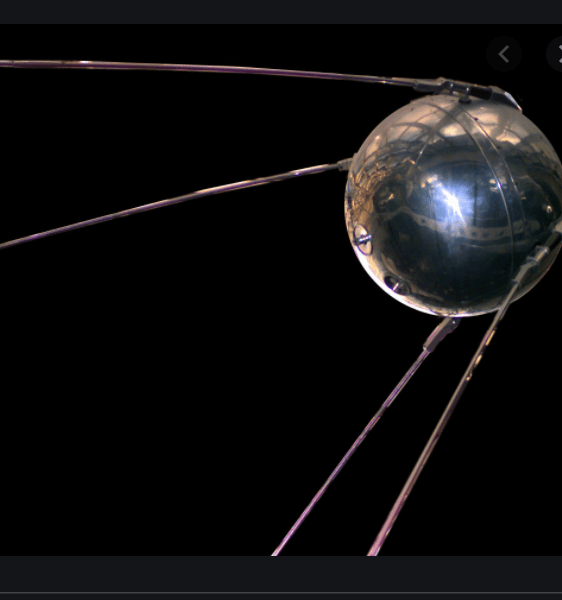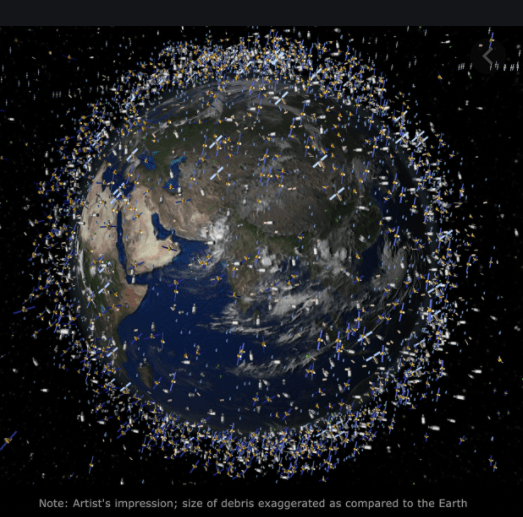by John Pickard
In the two centuries since its rapid development of industry, capitalism has developed science and technology as an integral part of its commercial and productive capacities. But in the age of the decline of capitalism, both science and technology are facing an impasse.
This is evident in many different spheres of life – such as climate change, species extinction, pandemics, global pollution, scarcity of resources, just to name a few – and most of these are saving up their real impact for major crises in the future.
Artificial satellites are another example. Since the first artificial satellite, Sputnik, launched by the Soviet Union in 1957, tens of thousands more have been sent into orbit. The ubiquitous mobile phone, internet links, TV and radio, weather forecasts, vehicle, aircraft and shipping navigation – all of these rely on satellites of one sort or another.
Redundant satellites decommissioned
Since the first launch over sixty years ago, the space above the planet has become crowded with old defunct satellites, as well as many bits and pieces of that have just broken off. Satellites that have become redundant have been simply decommissioned and mostly left there. Many of the later stages of the massive ‘vehicles’ used to launch satellites, especially in the early days, exploded through the presence of excess fuel and the shattered remnants of these are still out there.
The result is that space is full of junk, millions of pieces of it, from large items perhaps the size of a fridge-freezer, to nuts and bolts and tiny objects. The point being, of course, that they all pose a danger to other functioning satellites and the International Space Station, which is still functioning.
Sputnik has long since burned up on re-entering the atmosphere after its orbit gradually decayed, but just to show how long satellites can hang about, another early satellite, the US Vanguard 1 is still up there, because of its high orbit. It was launched in 1958 and is now the oldest piece of space junk there is. Some bits will continue to orbit for millions of years.
Three categories of junk
According to a study by Bologna University eight years ago, there were already millions of pieces of junk even then. The amount of junk and the danger to other satellites depends on the height of the orbit. The higher the orbit, the less crowded the junk is, and therefore the less danger there is. On the other hand, material orbiting at, say 1,500km above the Earth, might stay there for millions of years.
Bologna defined three categories of junk. The largest, capable of destroying a working satellite, are all those pieces larger than 10cm. Although these are ‘trackable’ – and indeed are tracked by space agencies – there are at least 19,000 of them.

The next largest, over 1cm in size, are only ‘potentially’ trackable and may cause serious damage to a working satellite, but there are ‘several hundred thousand’ of them. Finally, there are the ‘untrackable’ bits and pieces, less than 1cm is diameter, of which there may be millions or even billions. Even these, however, travelling at up to 8km every second, can cause damage.
The Bologna University study highlighted a number of significant events that have increased the amount of space junk. For example, in 2007, China conducted an anti-satellite test, in which a missile was used to destroy an old weather satellite, adding over 3,000 new pieces of debris. Then two years later, a defunct Russian satellite accidentally collided with and destroyed a US commercial satellite, adding another 2,000 trackable bits of debris.
Since then, the European Space Agency Awareness programme has started and a number of US commercial players have started putting up new satellites in their thousands.
Elon Musk aims for thousands of satellites
Elon Musk, using his SpaceX programme, has already launched 60 ‘Starlink’ satellites. He can boast, the Financial Times explained (March 31) “that in 22 months his constellation has put almost as many small satellites into “Low Earth Orbit” as were launched globally in the decade to 2018.”
His rival Jeff Bezos, owner of Amazon, is also talking up his own Space programme. Like Musk, Bezos will be aiming to put his own satellites into Low Earth Orbit and many other programmes around the world are aiming to do the same. Musk and others are arguing for the LEO ‘licences’ to be widened on the grounds that these satellites are so low (no higher than about 600 km) that eventually their orbits decay and the satellite burns up in the atmosphere – thereby being ‘environmentally friendlier’.
The problem is that if all the agencies and companies do the same, it makes for a lot of satellites. There are as many as 90 different companies and governments with the same ambitions of putting up LEO satellites. Musk is talking about 12,000 satellites from his company alone. His Starlink programme already has 1,320 and he aiming to add around 120 a month.
Then, the Financial Times adds, there is Amazon’s Project Kuiper “with its 3,200 satellites, Britain’s OneWeb with about 700 and Telesat of Canada with 298. The EU, too, is talking about its own constellation while China is planning multiple systems”.
It will only get more crowded
Over the next decade, Euroconsult plans to put up over 10,000 mini-satellites into LEO, more than five times more than in the whole of the previous decade. China and Russia will no doubt be sending up thousands more of their own. It is already crowded up there and it will become more crowded. There are no international laws or treaties that govern the use of satellites or the clear up of debris when something goes wrong.

At the moment, this problem is not seen as ‘acute’, because even with tens of thousands of satellites, the perception is that space is a big place. As indeed it is. However, the more crowded it gets, the more that the likelihood of accidental damage increases. And it must be borne in mind that every collision with space debris multiplies the number of pieces of debris up there.
This is not a ‘technological’ or a ‘scientific’ question. It is political. If we lived in a society in which the resources and technology of the world were planned in a rational way, including use of space and space technology, it is the kind of issue that would be factored into space and communication programmes. But given international geo-political rivalries between the great powers, and the inevitable commercial competition between big corporations, there is almost no chance of that happening.
If science and technology were properly planned, as in a socialist environment, far better use could be made of satellite programmes and space research, without simply using the sky as a vast junkyard. But until there is a complete change of system down here on Earth, the chaos and anarchy above our heads will continue…while we all wait with fingers crossed.



